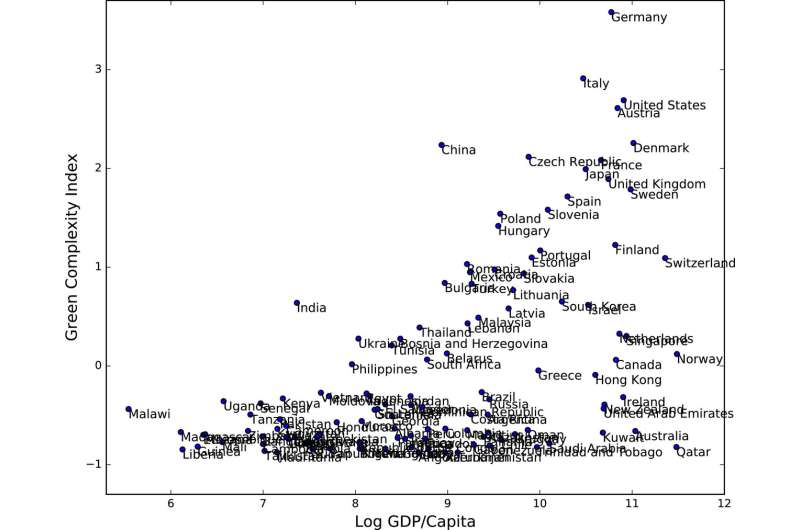Identifying the green growth tigers of the 21st century

China, Italy, U.S. and the UK among countries that could win big in the global transition to a green economy, finds new research from the University of Oxford.
For the first time, economists have ranked countries' current green production capabilities, indicating which countries are likely to be leaders in the green economy.
Green growth is seen by many as a way to stop global warming while continuing to improve quality of life, including for the 1.3 billion people who still live in extreme poverty. But while some countries will thrive in this new green economy, others could be left behind.
Achieving green growth requires the development and diffusion of technologies with environmental benefits, such as wind turbines, solar panels or equipment to monitor air pollution.
"As the world shifts towards a greener, cleaner competitive landscape, being able to produce and export environmentally friendly products is likely to become more important", said Dr. Penny Mealy, lead author and researcher at the Smith School of Enterprise and the Environment, University of Oxford. "Our analysis sheds light on which countries are likely to be the green growth tigers of the 21stcentury".
To investigate countries' green production capabilities, the researchers built the world's first and largest database of internationally recognised green products. Each of these products has an associated complexity score indicating how technologically sophisticated it is—for example, bicycle frames score lower than the optics used in concentrated solar power. Economists have shown that countries that export more complex products tend to experience faster growth.
Based on this database, the researchers created a new measure—the Green Complexity Index (GCI) – that shows which countries are able to export the most green, complex products. They found that countries with high per capita GDP, such as Germany, the United States and the UK, also often tended to rank more highly in terms of their green production capabilities.
However, some countries with high GDP, particularly those with emphasis on fossil fuel extraction such Australia, Norway and the United Arab Emirates, showed low GCI. This shows low current investment in green production and indicates that a switch to green products might be difficult in future.
Other highly ranked countries include China and Italy. Countries with a higher GCI also tended to have higher environmental patenting rates, lower CO2 emissions and more stringent environmental policies.
"International organizations have struggled to create a unified list of green products," explained Dr. Alexander Teytelboym, study author and researcher at the Department of Economics, University of Oxford "We have made ours freely available so policy makers can use it to understand their green production capabilities and help speed up the transition to a green future."
The researchers also developed a methodology that helps countries re-orient their existing capabilities towards new green export opportunities. This involves mapping a set of green products that require similar production capabilities to countries' current exports.
It is much easier for countries to develop competitiveness in products that require similar skills, equipment and know-how to what they already know how to do. Germany, for example, developed turbine manufacturing off of existing expertise in high precision machining. For some countries, many products are in reach. But for others, the transition will be much more difficult.
"Understanding green export opportunities is particularly useful for informing green industrial strategies or even for designing green stimulus packages," said Dr. Penny Mealy. "As policymakers search for ways to stimulate the economy in the midst of the current global pandemic, investing in countries' green production capabilities could be a much-needed win-win."
More information: Penny Mealy et al. Economic complexity and the green economy, Research Policy (2020). DOI: 10.1016/j.respol.2020.103948


















